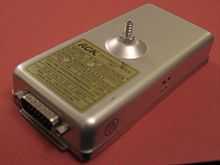Gillham code
| Gillham code | |
|---|---|
 A Cessna ARC RT-359A transponder (the beige box) in the instrument panel of an American Aviation AA-1 Yankee light aircraft. The transponder gets its altitude information from an encoding altimeter mounted behind the instrument panel that communicates via the Gillham code. |
Gillham code is a digital code using an eleven-wire interface that is used to transmit uncorrected barometric altitude between an encoding altimeter or analog air data computer and a transponder. It is a modified form of a Gray code and is sometimes referred to as a "Gray code" in avionics literature.[1]
Altitude encoder

An altitude encoder takes the form of a small metal box containing a pressure sensor and signal conditioning electronics.[2][3] The pressure sensor is often heated, which requires a warm-up time during which height information is either unavailable or inaccurate. Older style units can have a warm-up time of up to 10 minutes; more modern units warm up in less than 2 minutes. Some of the very latest encoders incorporate unheated 'instant on' type sensors. During the warm-up of older style units the height information may gradually increase until it settles at its final value. This is not normally a problem as the power would typically be applied before the aircraft enters the runway and so it would be transmitting correct height information soon after take-off.[4]
Light aircraft electrical systems are typically 12 V or 28 V. To allow seamless integration with either, the encoder uses a number of open-collector (open-drain) transistors to interface to the transponder. The height information is represented as 11 binary digits in a parallel form using 11 separate lines designated D2 D4 A1 A2 A4 B1 B2 B4 C1 C2 C4.[5] The Gillham code contains a D1 bit but this is unused in practical applications.
Different classes of altitude encoder do not use all of the available bits. All use the A, B and C bits; increasing altitude limits require more of the D bits. Up to and including 30700 ft does not require any of the D bits. This is suitable for most light general aviation aircraft. Up to and including 62700 ft requires D4. Up to and including 126700 ft requires D4 and D2. Note that D1 is never used.[1]
Decoding
Bits D1–B4 use a standard Gray code to store the number of 500 ft increments and Bits C1–C4 use a standard Gray code to store the number of 100 ft increments.[5]
The Gillham code can be decoded using various methods. Standard techniques use hardware [6] or software solutions. The latter often uses a lookup table but an algorithmic approach can be taken.[7]
References
Further reading
- Industry Specifications
- Annex 10 - Volume IV - Surveillance Radar and Collision Avoidance Systems; 4th Edition; ICAO; 280 pages; 2007.
- DO-181E Minimum Operational Performance Standards for ATCRBS / Mode S Airborne Equipment; Rev E; RTCA; 2011.
| ||||||||||||||||||||||